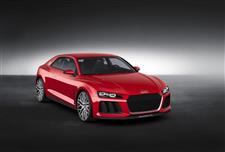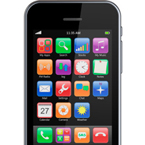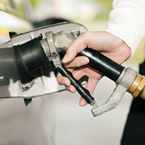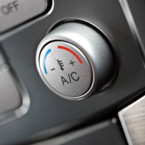 Catch up on the latest Audi tech news from DCH Millburn Audi Catch up on the latest Audi tech news from DCH Millburn Audi
As a luxury automaker, Audi takes technology seriously. At the International Consumer Electronics Show (CES) 2014, Audi showcased some significant new developments coming your way in 2014 and beyond. DCH Millburn Audi has the roundup of what you can expect.
The Audi Sport Quattro Laserlight concept made a dynamic appearance at the show, featuring an array of technologies including a plug-in hybrid drivetrain, innovative cabin layout, and laser headlights. This isn’t likely to be slated for production, but it does highlight new features which could make their way to an Audi near you. At DCH Millburn Audi, we especially like the laser diode high-beams (which Audi saws throw light two times as far and three times as brightly as LEDs) and the 700-horsepower hybrid powertrain.
On the opening day of CES 2014, Audi was also one of the automakers announced in a new partnership with Google to bring the Android operating system to vehicles. The group is called the Open Auto Alliance and will work to expand the vision of what connected car technology can become. “We have been in contact with government agencies like the National Highway Traffic Safety Administration (NHTSA),” the OAA said in a statement. “Our goal is to build an experience that helps drivers get what they’re looking for without disrupting their focus on the road.”
In addition, Audi demonstrated the latest generation of its Audi MMI® system. New intelligent input methods and an advanced “multi-touch” concept with tactile feedback represent an evolution in in-vehicle convenience.
DCH Millburn Audi is your destination to see current Audi technology firsthand. Visit us today to learn more.
Image: Audi of America
 We at DCH Millburn Audi wish you a smooth and enjoyable driving experience each time you sit behind the wheel of your vehicle. However, we recognize that equipment can occasionally malfunction, and if such an event were to occur, we want you to be prepared to deal with the situation. Here’s how we recommend that you react if your gas pedal sticks. We at DCH Millburn Audi wish you a smooth and enjoyable driving experience each time you sit behind the wheel of your vehicle. However, we recognize that equipment can occasionally malfunction, and if such an event were to occur, we want you to be prepared to deal with the situation. Here’s how we recommend that you react if your gas pedal sticks.
Stay Calm
Your adrenal glands will kick into action if your vehicle accelerates without your consent, so firstly remember to not panic. Take a deep breath and exhale—then assess the situation.
Attempt to Stop Your Car
Shift your vehicle into neutral, remembering to utilize the clutch if you drive a manual. Maneuver your car toward a shoulder or a safe place on the side of the road. Push the brake as firmly as possible, potentially using both feet if the pedal is stubborn.
Power Down
If your car is equipped with a push-button start, depress the button for at least 3 seconds to disable the vehicle. If your car does not have this button, turn the keys and turn off the engine if your situation has not slowed down. Be careful that you are oriented toward a safe spot since turning off the engine will deactivate assisted steering.
Call for Help
If this dangerous situation has transpired, your vehicle is in need of attention before you next drive it. Call our dealership—we will be happy to assist you.
 The phrase “parallel parking” is enough to strike fear into the hearts of even the most accomplished drivers. Students have failed countless driving examinations when they are forced to parallel park, as it is almost certainly one of the hardest maneuvers required to pass your driving test. However, parallel parking need not be such an ordeal. Find out why with these simple tips from DCH Millburn Audi to help you parallel park. The phrase “parallel parking” is enough to strike fear into the hearts of even the most accomplished drivers. Students have failed countless driving examinations when they are forced to parallel park, as it is almost certainly one of the hardest maneuvers required to pass your driving test. However, parallel parking need not be such an ordeal. Find out why with these simple tips from DCH Millburn Audi to help you parallel park.
Choose the right space
It may seem like stating the obvious, but in order to parallel park successfully, you have to be sure that the space is large enough for the vehicle that you are driving. Very skilled drivers can parallel park cars in smaller spaces than other drivers, but unless you see yourself as an expert, you may save time by simply picking a decent-sized space in the first place.
Let people know that you are parking
One of the problems with parallel parking is that it can cause impatience in other drivers, particularly if they are not sure that is what you are doing. When you have identified a space that you want to parallel park in, check your rearview mirror and side mirror to ensure that you signal early enough to give the driver behind you fair warning. If need be, roll down your window and wave him or her on to be absolutely clear. Be patient, too. Wait until other cars have passed before starting to park.
Line your car up first
Line up your car with the vehicle that is parked directly in front of the spot you want to move into. Do not get too close, or you may clip the other car when you make your move. Conversely, stay within two to three feet of the car. Line up your rear bumper with the other car to get yourself into the perfect starting position. Put your vehicle into reverse and then check your rearview mirror to ensure that it is safe to move. Look over your other shoulder towards the space so that you can assess the turn as you make it. Turn the steering wheel sharply to the right. Now release the brake and begin slowly backing into the space.
Look around you all the time
As you back into the space, check in front of and around your car all the time, assessing the amount of space you have. Stay a safe distance away from the bumper of the car in front of the space. Your rear tire may hit the curb—this means that you have reversed too far. Shift the gears and just pull forward a few feet before shifting back to reverse and carrying on. While still looking all around your car, turn the steering wheel to the left once the rear of the car is mostly in the space, staying in reverse until you are a safe distance from the car behind. Keep looking around you, shift into drive, and then move slowly forward to stop a reasonable distance from the car in front.
Keep calm
Throughout the process, remain calm and take your time. Erratic movements and haste will seldom get you into the space any quicker, and more often than not will mean that it takes much longer. If you make a mistake while reversing, take a deep breath, shift into gear and move forward, without rushing or panicking. Finally, do not let other road users hurry you along. Take the time to do it properly and you will be out of their way in no time.
 Keeping your car in full working order is not just about ensuring that you can rely on your vehicle when you need to. A well-maintained car will hold its resale value much more completely, and if you decide to sell your car on the second-hand market, you should get a much better price. If you lead a busy life, however, it can be difficult to keep on top of everything that needs doing when it needs doing. The good news is that there are a number of apps for your smartphone that can make life easier. Here are just four examples from DCH Millburn Audi. Keeping your car in full working order is not just about ensuring that you can rely on your vehicle when you need to. A well-maintained car will hold its resale value much more completely, and if you decide to sell your car on the second-hand market, you should get a much better price. If you lead a busy life, however, it can be difficult to keep on top of everything that needs doing when it needs doing. The good news is that there are a number of apps for your smartphone that can make life easier. Here are just four examples from DCH Millburn Audi.
Autolog – $1.99
Autolog combines a number of handy different features in one simple-to-use app. For a start, you can manage multiple cars, which makes this suitable for larger households. You can record the details of each service and maintenance trip separately, and you can also record trip data to monitor your overall mileage. Autolog also allows you to capture a detailed record of each car – not just the make and model, but the engine size, car color, VIN, and more.
Car Care – $4.99
Car Care is one of the most popular apps on the market. For a start, you can track the details for as many cars as you like. You can create detailed records of your fuel economy using a variety of different measurements. These statistics can help you track your gas economy according to different fuel types, so that you can find the optimum fuel for your car. Car Care will also remind you when you need to perform certain maintenance actions, with a series of alerts to prevent you missing important activities.
Car Minder Plus – $2.99
With Car Minder Plus, you can track all the important maintenance routines that you need to keep an eye on. That could include an oil change, new tires, or even when you might need new windshield wiper blades. With Car Minder Plus, you can record the details of all your gas mileage, and graph the fuel economy over a fixed period of time. You can also e-mail the vehicle’s service and repair history for as many vehicles as you need to track.
KBB for iPhone – Free
The Kelley Blue Book is the second-hand car market bible when it comes to tracking prices and values. The free iPhone app allows you to perform a number of functions if you are considering selling your car, or if you just want to track the value of your car as it stands. You can search prices for new and used cars, read professional and consumer reviews, and compare cars side-by-side. Location-based services allow you to find dealers in your area and get quotes from them.
Know of another app that makes maintaining your ride easier? Let us know!
 We are sure that you have heard many ideas about keeping your RPMs to a minimum and your fuel efficiency to a maximum. Appropriately inflated tires, cruise control, and a light vehicle load can all help you keep your wallet as thick as possible. We at DCH Millburn Audi want to keep you ahead of the curve though, so here are our latest ideas for maximum fuel efficiency. We are sure that you have heard many ideas about keeping your RPMs to a minimum and your fuel efficiency to a maximum. Appropriately inflated tires, cruise control, and a light vehicle load can all help you keep your wallet as thick as possible. We at DCH Millburn Audi want to keep you ahead of the curve though, so here are our latest ideas for maximum fuel efficiency.
Drive Defensively
If you are the aggressive type of driver, then understand that your attitude can influence how your foot behaves around the acceleration pedal. Aggressive driving can create higher speeds, sporadic acceleration, and a generally inefficient driving experience. Take it easy, keep a steady pace, and you will notice spending less time at the fuel pump.
Streamline Your Vehicle
Although a lot of the aerodynamics of your vehicle is predetermined by the Chevrolet research and development departments, there are some things that you can do to minimize drag. Always keep windows and moon roofs close on the freeway, and keep your vehicle free of debris.
Put it into High Gear
If you operate a manual transmission, then you likely understand that the higher the gear, the lower the engine works. Don’t redline your engine in first and second, and always try to smoothly and safely transition into the highest gear available as quickly as possible.
Carpool
Find friends in classes or at work and determine who lives near you. You can swing by on the way to your job or school and ask them to pitch in for gas later on. A carpooling initiative at your work or school might be the perfect idea to get everyone excited and working together. Plus, having a buddy in the car will make your trips shorter!
Plan Your Errands
A warmer engine runs more efficiently than a stale, cold one. If you have a to-do list than involves driving around town, plan out the most efficient route and try to carry it out with as little engine downtime as possible.
We hope these tips help you pinch pennies during each mile that you travel.
 You’re familiar with those perspiration-like beads that form on the outside of a cold beer bottle. That’s moisture condensing out of the atmosphere. The drips can be irritating, but they won’t ruin your day. But when condensation occurs in your car’s fuel tank the impact can be far more serious. Read on to learn how to avoid this mishap from our team at DCH Millburn Audi. You’re familiar with those perspiration-like beads that form on the outside of a cold beer bottle. That’s moisture condensing out of the atmosphere. The drips can be irritating, but they won’t ruin your day. But when condensation occurs in your car’s fuel tank the impact can be far more serious. Read on to learn how to avoid this mishap from our team at DCH Millburn Audi.
Gasoline and water don’t mix. Usually the water sinks to the bottom, from where it can get drawn in to the engine. And as water doesn’t burn, your engine is going to cough and splutter. That’s not the end though. Where there’s water, corrosion isn’t far behind, and a fuel tank with water in it can start to rust from the inside, as can the fuel lines.
Throw in freezing temperatures and the problems multiply. When water in fuel lines turns to ice the engine will be starved of gasoline and you won’t be going anywhere until things warm up.
There are three main ways water gets into the fuel tank: it was in the gas station’s storage tanks, it got past a badly fitted gas cap (perhaps when using a car wash or during a rainstorm,) and condensation. The first you can avoid by patronizing gas stations that do a high volume of business. (Rapid turnover keeps the tanks filled with gasoline.) The second is just common sense, and as for avoiding condensation… well here are some suggestions.
Condensation comes from water vapor in the air. The amount of vapor air can hold is closely related to its temperature: warm, moist air holds more than cold, dry air. Armed with this knowledge you’ll see that the keys to reducing condensation are to minimize both the amount of air in the tank and the temperature range it sees.
Keeping the fuel tank full is perhaps the easiest step. The less air inside, the less water vapor there will be to condense out when the temperature drops. As for minimizing temperatures, if a temperature-controlled garage is out of the question, the next best thing is to limit exposure to extremes.
If the car is garaged, avoid leaving the door open on frigid winter days as cold air will quickly chill the air in the tank. And conversely, don’t let the garage get too hot in summertime as a cool night will lead to moisture in the air in the tank condensing out. Insulation in the garage roof space will help, and you could try cracking the door open a touch too.
But what if, despite your best efforts, you think water has found a way into your fuel tank? Bring your car or truck into our dealership. We’ll be happy to determine if water really is the cause of your problems.
The survivors of the devastating Typhoon Haiyan in the Philippines are in desperate need of help. DCH Auto Group has responded to this urgent call for aid by making a donation to the International Red Cross.
“Our deepest sympathy goes out to anyone who has been affected by the terrible typhoon,” said George Liang, President of DCH Auto Group. “Our donation to the International Red Cross, helping the victims of this improbable disaster, is an extension of DCH Auto Group’s unyielding embrace of the tenants of corporate citizenship.”
Headquartered in South Amboy, New Jersey, DCH Auto Group owns and operates a wide array of car dealerships – including Acura, Audi, BMW, Chrysler, Dodge, Honda, Jeep, Lexus, Nissan, Scion, and Toyota – located in Southern California, Connecticut, New Jersey and New York. DCH Auto group is a firm believer in good corporate citizenship and working to improve the lives of others in each community DCH does business. Each of DCH Auto Group’s 27 dealerships regularly works with local charities and non-profit groups, including local high school chapters of Students Against Destructive Decisions (SADD).
All of us at DCH Millburn Audi, along with our fellow DCH Auto Group team members, extend our thoughts and prayers for the people of the Philippines.
 When ice covers the neighborhood pond, it makes skaters happy. But when ice covers the roads and highways, drivers feel quite differently about the slippery substance. When ice covers the neighborhood pond, it makes skaters happy. But when ice covers the roads and highways, drivers feel quite differently about the slippery substance.
Ice is a major cause of winter accidents because it’s not always visible. Also, some drivers feel overconfident about driving on ice due to their car’s high-tech safety features.
Overconfident drivers may end up ruing their lack of precaution, however, if treacherous ice causes them to slip, slide, skid and spin wildly out of control. These five tips from DCH Millburn Audi will help you stay on solid ground even if it’s a sheet of solid ice.
Buckle up and put on your defroster
You should wear your seat belt at all times, but especially during icy conditions when accidents occur at a greater rate than normal. Put on your defroster, too. Your defroster helps to keep your car windows from forming ice and melts snow if you’re facing the double winter whammy of ice and snow.
You always need to keep your visibility clear but especially in bad weather. Prepare for the unexpected and be on high alert for potential dangers like skidding, slipping or stalled cars blocking the road.
Slow it down
Seems like all drivers should know it’s important to reduce their speed when driving on icy pavement, but some drivers think that snow tires, all-wheel drive (AWD) and electronic stability control (ESC) will eliminate slipping and sliding.
Good tires help to grip the pavement, AWD assists in accelerating and staying mobile, and ESC helps to avoid spinouts, but even improved traction won’t keep you safe if you’re traveling at speeds too high for icy conditions. By reducing your speed, you give yourself a better chance to stop safely, to stay on the road, and to get where you’re going in one piece.
Don’t stomp on the brakes
When the roads are icy, you have to drive with greater caution and with slower, gentler actions. Brake softly, and try to avoid sudden hard stops which can initiate a spin that you may not recover from. If you do find yourself skidding:
- Immediately, take your foot off the gas pedal or brake
- Let the car naturally slow down and gain traction
- Steer in the direction you want the car to go
- As your traction improves, gently brake or accelerate as needed
- Avoid over steering or sudden sharp turns
If you’re walking on ice and quickly twist your feet in another direction, most likely you’ll fall. That’s why people walk cautiously and prudently on icy patches. Same thing goes for your car. Sudden, quick, steering maneuvers can create skidding just like over braking.
Follow the skidding advice above, because it doesn’t’ matter how or where you’re attempting to steer the car’s wheels if they have no traction. Only when the tires are gripping the road and actually rolling can turning the steering wheel alter their direction and yours.
Be aware of road conditions
Check social media, TV or the radio to see what meteorologists are saying about the weather. Low temperatures and even a few droplets of precipitation can make ice. Also, keep in mind, black ice may look like an innocent puddle, but if you know it’s 31 degrees outside and there’s light rain, you should treat the roads like a sheet of ice whether you can see it or not.
 The daily morning car-warming ritual is carried out faithfully in most parts of the country from late November to early March. But is it necessary? DCH Millburn Audi has the answer. The daily morning car-warming ritual is carried out faithfully in most parts of the country from late November to early March. But is it necessary? DCH Millburn Audi has the answer.
The purpose of warming up your car. The main reason drivers start their car and let it idle is to warm it up by getting the oil circulating through the engine. Modern fuel injection systems, however, with the elimination of carburetors and chokes, have made engine idling unnecessary. After about 30 seconds, the oil is circulating and your car is ready to go. The Hinkle Charitable Foundation’s Anti-Idling Primer, in fact, asserts that idling forces the engine to operate in an extremely inefficient mode, which can harm the engine’s performance and lower its mileage. If you’re still skeptical, instead of idling, drive a little slower for the first mile or two.
Warming up the inside. Many commuters couldn’t care less about engine efficiency at 6:00 a.m. in the morning when it’s frigid cold. Instead, they just want a semi-warm vehicle to step into when it’s cold. However, according to the California Energy Commission, idling your car isn’t an effective way to warm up a vehicle. A more effective way to warm up your car is to actually drive it. If you really want to be on the cutting edge, electric cars allow you to pre-warm the vehicle via remote access without ever having to idle.
Idling and the environment. Still not convinced about the inefficiency of idling to warm up the vehicle? Perhaps you think engine inefficiency is a small price to pay for not freezing your fingertips when you enter your car. Maybe, a look at environmental effects will unfreeze your stance. Exhaust is harmful to human health, especially children. Certainly, exhaust is a necessary component of driving a car, but unnecessarily spewing exhaust adds to air pollution. Because idling often takes place close to curbs and sidewalks, pedestrians and children are especially at risk to the negative effects of exhaust.
The cost of idling. If air pollution and the potential harmful effects of unnecessary exhaust don’t convince you to cut down on idling, perhaps the cost of gasoline will. Idling wastes gas. Gas costs money, therefore idling wastes money — your money. Motorists are advised to turn off their engine when idling more than 10 seconds (traffic stops, excluded). You’ll save money. You’ll save the environment. You’ll save your engine. A new engine, by the way, costs money too. A lot of money.
Proper car warming procedures. Don’t stand by idly and let this information go to waste. If you’re worried about your engine’s performance, warm the car by driving it slowly. If you’re worried about being cold when you hop in the car, bundle up, start the car, adjust the radio, turn on the heat and get going.
 Q. If I have a window chip repaired, could it still develop into a full blown crack? Q. If I have a window chip repaired, could it still develop into a full blown crack?
A. Nothing lasts forever, including windshield repair. Because no two cracks or dings are alike, there’s no hard and fast rule about how long a repair will last. Read on for a detailed explanation of what to do if and when your windshield cracks from our service team at DCH Millburn Audi.
The size, severity and location of the crack, as well as the quality of the repair, all play a role in the life of the repair. There’s no guarantee that that three-inch crack won’t spread.
Many repairs are as strong as the original glass, but you just won’t know until it fails. Making sure you go to a reputable shop will help you get the highest quality repair job– your dealer is a good choice if you have a new car. Over-the-counter kits are a bit dicey.
If the worst should happen and you need to replace your windshield, make sure you get OEM (Original Equipment Manufacturer) glass. OEM glass is made to the same specifications as your original windshield. Aftermarket glass is often cheaper, but, unfortunately, you get what you pay for. Inferior quality glass can be a poor fit causing whistling and leaks and, worse yet, it can pose a safety risk. This is one area where spending a little more is definitely worth it.
|
 Catch up on the latest Audi tech news from DCH Millburn Audi
Catch up on the latest Audi tech news from DCH Millburn Audi










